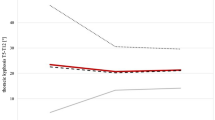Abstract
Ventral derotation spondylodesis, according to Zielke, achieves good results in operative treatment of idiopathic thoracic scolioses. Corrections of scoliotic major and secondary curve as well as derotation of the spine are reliably performed. The high rate of rod fractures with subsequent correction loss as well as a proportionate kyphogenic effect represents a problem. By keeping to the correcting principle, anterior double-rod instrumentation (Halm-Zielke Instrumentation) is to be stable in a similar way as posterior double-rod systems. Thus, it is done to facilitate brace-free postoperative care and to prevent excessive kyphotic pattern of the spine. In this prospective study, we retrospectively collected data. We performed radiological follow-up of two groups of patients with idiopathic thoracic scoliosis (King II, III and IV) undergoing an operation with posterior approach (USS instrumentation, posterior group, n=104) in 1997 and 1998 or being corrected with an anterior fusion (Halm-Zielke instrumentation, anterior group, n=37) between 2000 and 2001. Mean age of all patients for operation was 15±4 years. Follow-up was performed after 4±2 years on average. Preoperative measurements of the major and secondary curve, the lateral profile, rotation and frontal balance (C7 to S1) did not show any significant differences apart from a more severe scoliotic curve in the lumbar spine for the anterior group with appropriately higher lumbar rotation. During follow-up we noticed similar corrections of the thoracic major and lumbar curve in both groups ranging from 49 to 56%. In case of hypokyphotic (T4–T12≤20°) scoliosis a kyphogenic effect on the thoracic spine was achieved with both surgical methods. Hyperkyphotic (T4–T12≥40°) scolioses were flattened by posterior spinal fusion; the effect of anterior spinal fusion was not significant. Correction of thoracic and lumbar rotation in the anterior group by 37 or 30% was more significant than in the posterior group by 27 or 20%. There was no impact of anterior technique on the balance of the spine whereas the latter shifted by an average of 7 mm to the left in the posterior group. The number of fused segments was significantly smaller in the anterior group with 7±1 vertebral bodies (posterior, 11±1 vertebral bodies). Rates of complication were identical with 11 or 12% in both groups during follow-up. Anterior and posterior double-rod instrumentations result in comparable corrections for idiopathic thoracic scoliosis of the major and secondary curve. In case of posterior technique, however, four vertebral bodies less were integrated in spondylodesis on average. Balance of the spine did not change after anterior spondylodesis; however, it declined by using the posterior technique. Augmentation of the anterior threaded rod combined with a solid second rod significantly decreases the rate of implant breakages and reliably reduces consecutive correction losses.




Similar content being viewed by others
References
Bauer R, Kerschbaumer F, Poisel S, Härle A (1991) Zugangswege. In: Bauer R, Kerschbaumer F, Poisel S (eds) Orthopädische Operationslehre Bd. 1. Thieme, Stuttgart, pp 13–72
Benli IT, Akalin S, Kis M, Citak M, Kurtulus B, Duman E (2000) The results of anterior fusion a Cotrel–Dubousset–Hopf instrumentation in idiopathic scoliosis. Eur Spine J 9:505–515
Bernstein RM, Hall JE (1998) Solid rod short segment anterior fusion in thoracolumbar scoliosis. J Pediatr Orthop [B] 7:124–131
Betz RR, Harms J, Clements DH III, Lenke LG, Lowe TG, Shufflebarger HL, Jeszenszky D, Beele B (1999) Comparison of anterior and posterior instrumentation for correction of adolescent thoracic idiopathic scoliosis. Spine 24:225–239
Betz RR, Lenke LG, Lowe GT (2000) Proximal screw pull-out during anterior instrumentation for thoracic scoliosis: preventive techniques. In: 35th annual meeting scoliosis research society. Cairns, p 156
Bridwell KH, Betz R, Capelli AM, Huss G, Harvey C (1990) Sagittal plane analysis in idiopathic scoliosis patients treated with Cotrel–Dubousset instrumentation. Spine 15:921–926
Bridwell KH, McAllister JW, Betz RR, Huss G, Clancy M, Schoenecker PL (1991) Coronal decompensation produced by Cotrel–Dubousset “derotation” maneuver for idiopathic right thoracic scoliosis. Spine 16:769–777
Bullmann V, Halm HF, Lepsien U, Hackenberg L, Liljenqvist U (2003) [Selective ventral derotation spondylodesis in idiopathic thoracic scoliosis: a prospective study]. Z Orthop Ihre Grenzgebiete 141:65–72
Bullmann V, Halm HF, Niemeyer T, Hackenberg L, Liljenqvist U (2003) Dual-rod correction and instrumentation of idiopathic scoliosis with the Halm-Zielke instrumentation. Spine 28:1306–1313
Cotrel Y, Dubousset J, Guillaumat M (1998) New universal instrumentation in spinal surgery. Clin Orthop 227:10–23
Dwyer AF (1973) Experience of anterior correction of scoliosis. Clin Orthop 93:191–206
Dwyer AF, Schafer MF (1974) Anterior approach to scoliosis: results of treatment in fifty-one cases. J Bone Joint Surg [Br] 56:218–224
Ecker ML, Betz RR, Trent PS, Mahboubi S, Mesgarzadeh M, Bonakdapour A, Drummond DS, Clancy M (1998) Computer tomography evaluation of Cotrel–Dubousset instrumentation in idiopathic scoliosis. Spine 13:1141–1144
Halm H (1994) Augmentation of VDS (ventral derotation spondylodesis) using a double-rod instrumentation: surgical method and early results. Z Orthop Ihre Grenzgebiete 132:383–389
Halm H (2000) Ventral and dorsal correcting and stabilizing methods in idiopathic scoliosis. Long-term outcome. Orthopäde 29:563–570
Halm HF, Liljenqvist U, Niemeyer T, Chan DP, Zielke K, Winkelmann W (1998) Halm-Zielke instrumentation for primary stable anterior scoliosis surgery: operative technique and two years results in ten consecutive adolescent idiopathic scoliosis patients within a prospective clinical trial. Eur Spine J 7:429–434
Hammerberg KW, Zielke K (1985) VDS Instrumentation for idiopathic thoracic curvatures. Presented at the American Academy of Orthopedic Surgeons annual meeting, Las Vegas
Hopf C, Schaub T (1989) A computed tomographic analysis of vertebral rotation before and after surgical correction of idiopathic scoliosis. Rofo 151:408–413
Hopf C, Eysel P, Dubbousset J (1995) CDH: preliminary report on a primary stable anterior spinal instrumentation. Z Orthop Ihre Grenzgebiete 133:274–281
Hopf C, Eysel P, Dubousset J (1997) Operative treatment of scoliosis with Cotrel–Dubousset–Hopf instrumentation: new anterior spinal device. Spine 22:618–628
Horton WC, Holt RT, Johnson JR, Leatherman KD (1988) Zielke instrumentation in idiopathic scoliosis: late effects and minimizing complications. Spine 13:1145–1149
Kaneda K, Fujiya N, Satoh S (1986) Results with Zielke instrumentation for idiopathic thoracolumbar and lumbar scoliosis. Clin Orthop 205:195–203
Kaneda K, Shono Y, Satoh S, Abumi K (1997) Anterior correction of thoracic scoliosis with Kaneda anterior spinal system. Spine 22:1358–1368
King HA, Moe JH, Bradford DS, Winter RB (1983) The selection of fusion levels in thoracic idiopathic scoliosis. J Bone Joint Surg [Am] 65:1302–1313
Krismer M, Bauer R, Sterzinger W (1992) Scoliosis correction by Cotrel–Dubousset instrumentation. The effect of derotation and three dimensional correction. Spine 17:S263–S269
Lenke LG, Bridwell KH, Baldus C, Blanke K, Schoenecker PL (1993) Ability of Cotrel–Dubousset instrumentation to preserve distal lumbar motion segments in adolescent idiopathic scoliosis. J Spinal Disord 6:339–350
Lenke LG, Betz RR, Bridwell KH, Harms H, Clements DH, Lowe TG (1999) Spontaneous lumbar curve coronal correction after selective anterior or posterior thoracic fusion in adolescent idiopathic scoliosis. Spine 24:1663–1671
Lieberman IH, Khazim R, Woodside T (1998) Anterior vertebral body screw pullout testing: a comparison of Zielke, Kaneda, Universal Spine System, and Universal Spine System with pullout-resistant nut. Spine 23:908–910
Liljenqvist U, Halm H (1998) Augmentation of the VDS with double-rod-instrumentation: a critical analysis of 2–4 years results. Z Orthop Ihre Grenzgeb 136:50–56
Lowe TG, Peters JD (1993) Anterior spinal fusion with Zielke instrumentation for idiopathic scoliosis: a frontal and sagittal curve analysis in 36 patients. Spine 18:423–426
Luk KD, Leong JC, Reyes L, Hsu LC (1989) The comparative results of treatment in idiopathic thoracolumbar and lumbar scoliosis using Harrington, Dwyer and Zielke instrumentation. Spine 14:275–280
Majd ME, Castro FP Jr, Holt RT (2000) Anterior fusion for idiopathic scoliosis. Spine 25:696–702
Moe JH, Purcell DA, Bradford DS (1983) Zielke instrumentation (VDS) for correction of spinal curvature: analysis of results in 66 patients. Clin Orthop 180:133–153
Moskowitz A, Trommanhauser S (1993) Surgical and clinical results of scoliosis surgery using Zielke instrumentation. Spine 18:2444–2451
Ogiela DM, Chan DP (1986) Ventral derotation spondylodesis: a review of 22 cases. Spine 11:18–22
Otani K, Saito M, Sibasaki K (1997) Anterior instrumentation in idiopathic scoliosis: a minimum follow up of 10 years. Int Orthop 21:4–8
Perdriolle R, Vidal J (1987) Morphology of scoliosis: three-dimensional evolution. Orthopedics 10:909–915
Puno RM, Johnson JR, Ostermann PA, Holt RT (1989) Analysis of the primary and compensatory curvatures following Zielke instrumentation for idiopathic scoliosis. Spine 14:738–743
Schlenzka D, Poussa M, Muschik M (1993) Operative treatment of adolescent idiopathic thoracic scoliosis. Harrington-DTT versus Cotrel–Dubousset instrumentation. Clin Orthop 297:155–160
Shufflebarger HL, Clark CE (1990) Fusion levels and hook patterns in thoracic scoliosis with Cotrel–Dubousset instrumentation. Spine 15:916–920
Trammel TR, Benedict F, Reed D (1991) Anterior spine fusion using Zielke instrumentation for adult thoracolumbar and lumbar scoliosis. Spine 16:307–316
Turi M, Johnston CD, Richards BS (1993) Anterior correction of idiopathic scoliosis using TSRH instrumentation. Spine 18:417–422
Webb JK, Burwell RG, Cole AA, Lieberman I (1995) Posterior instrumentation in scoliosis. Eur Spine J 4:2–5
Zielke K (1982) Ventral derotation spondylodesis: result of treatment of cases of idiopathic lumbar scoliosis. Z Orthop Ihre Grenzgebiete 120:320–329
Zielke K, Berther A (1982) VDS—ventral derotation spondylodesis: preliminary report on 58 cases. Beitr Orthop Traumatol 25:646–669
Zielke K, Stunkat R, Beaujean F (1976) Ventral derotation spondylodesis. Arch Orthop Unfallchir 19:257–277
Author information
Authors and Affiliations
Corresponding author
Rights and permissions
About this article
Cite this article
Muschik, M.T., Kimmich, H. & Demmel, T. Comparison of anterior and posterior double-rod instrumentation for thoracic idiopathic scoliosis: results of 141 patients. Eur Spine J 15, 1128–1138 (2006). https://doi.org/10.1007/s00586-005-0034-3
Received:
Revised:
Accepted:
Published:
Issue Date:
DOI: https://doi.org/10.1007/s00586-005-0034-3




